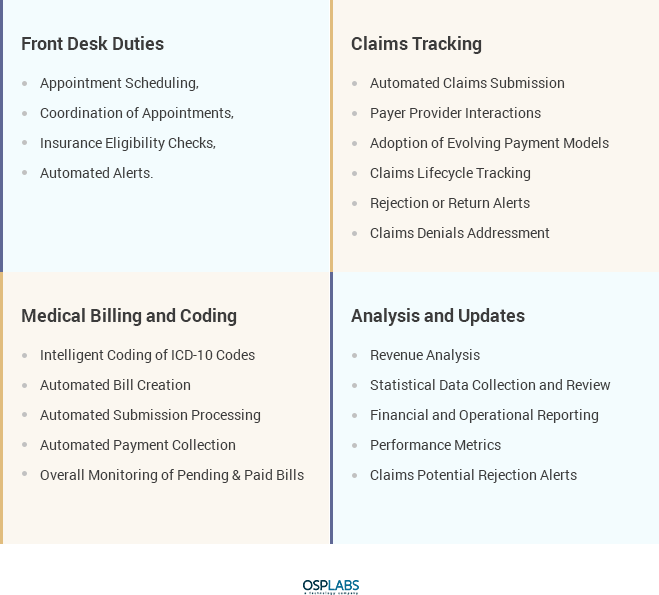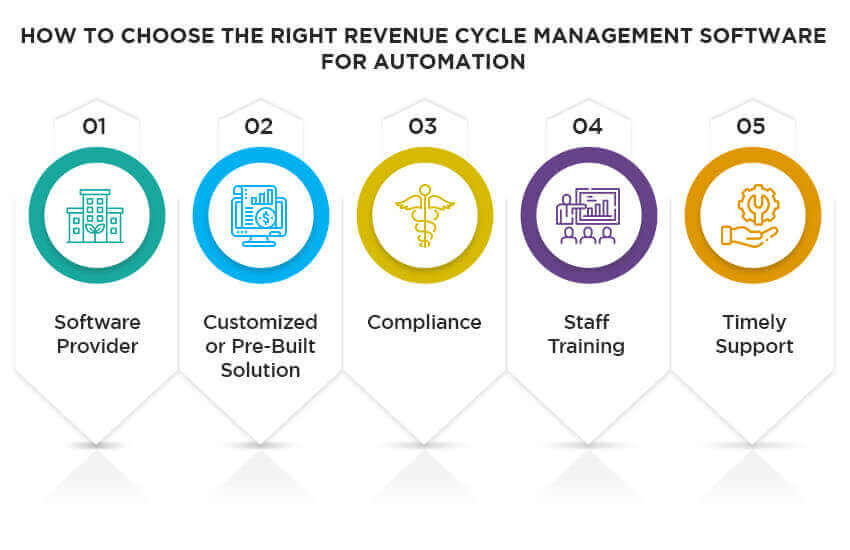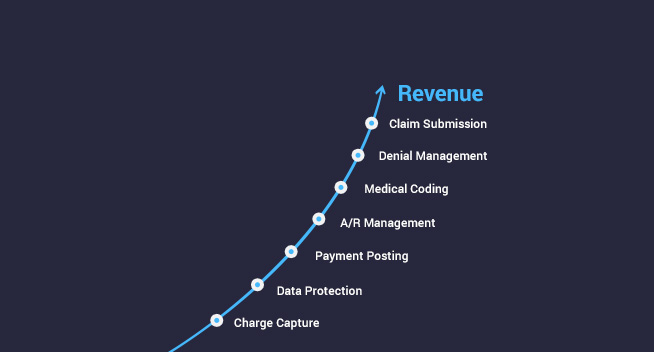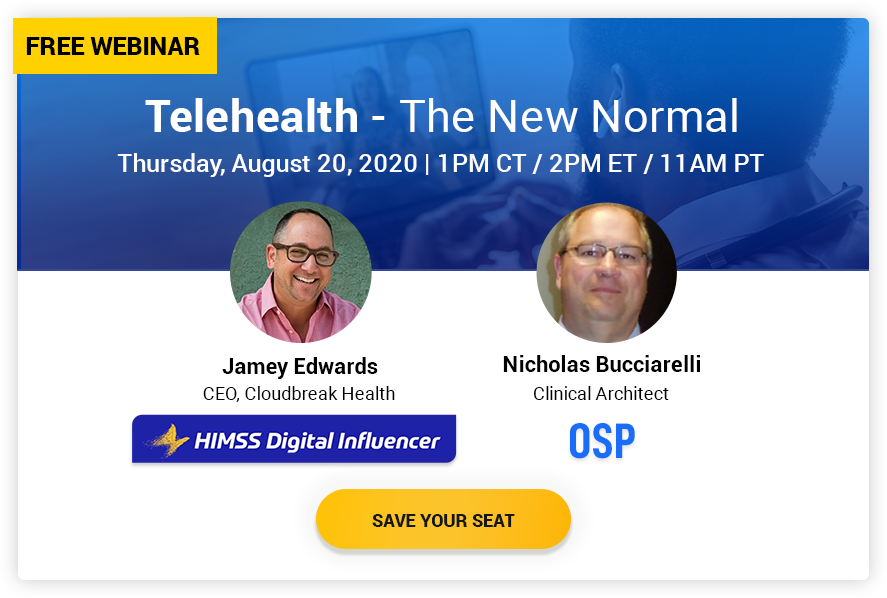There is an urgent need, among the healthcare sector, for an overall organization and establishment of systematic processing and policy adherence. This is the key for healthcare organizations to stay financially stable and enduring. Revenue cycle management, in a nutshell, is the central unit that manages these processes and policies. All the administrative and medical functions, associated with the finances of the organization, come under the umbrella of medical revenue cycle management. It further includes claims reimbursement, claims processing, revenue evaluation and generation, identification of bills, creation of invoices, and collection of payments. It is the central life vein of every medical practice.
The Need for Automation:
The cycle is initiated when medical services are imparted to a patient and is only complete when all relevant claims and subsequent payments have been made. This process brings with it increasing complexities and the need for systematic revenue cycle management is crucial. There following factors need to be addressed:
- Scheduling Appointments – The process of creating a systematic, yet patient-centric process of scheduling appointments that offer the patient the time priority that they require.
- Insurance Eligibility Verification – The insurance details and eligibility criteria are acquired from the patient and then verified through relative protocol.
- Patient Account Establishment – A process that initiates the patients account within the organization and is consistently updated based on the services offered.
- Medical History Identification – A thorough study and record maintenance that dwells into the medical history of the patient and all relevant factors that may or may not affect the patient’s health.
- Insurance Coverages – Identifying the patients insurance mandates and coverage and their relevant impact on the due processes for claims reimbursement, denial managements, etc.
- Patient Claims History – An analysis of the history of the patient, which identifies if any claims have been rejected in the past, along with a record of the relative denial management.
- Medical Billing – The process of creating accurate medical bills for the services rendered.
- Coding and Claims – Medical coding summarizes the clinical encounter for claims to be prepared and sent to payers. Automating the coding process accelerates and prevents errors that might result in claim denials. This is one of the most talked-about implementations of healthcare automation.
Automating the healthcare revenue cycle can help in the following ways:
- Pre-registration – An automated process that creates an account for the patient, with medical history details, insurance coverage, and all other relevant data.
- Patient Scheduling – This process undertakes a systematic approach to providing patient appointments at the initial stage and all subsequent appointments, keeping the patient as the priority.
- Automated Billing – Invoices are created through basic data entries, claims are identified, verification is undertaken, medical bills are generated, claims are submitted; all in the most seamless and efficient manner.
- Reduced Claims Rejection and Claims Returned – Through the ability to identify loopholes and human errors, the likelihood of rejection and returns of claims are drastically reduced.
- Efficient Claims Submission – The identification of the ICD-10 code is automated through simple information entries, along with the nature of treatments required. Reimbursement, therefore, is much faster.
- Charge Capture Duties Simplified – All services that translate into billable fees are identified and document through automatic relevance.
- Back-end Processes Optimized – Even after the claims are submitted, the ancillary processes of payment posting, processing of statements, collection of revenue and claims rejects or denials are handled through the automated software with very minimal human intervention.
- Quick Turnaround – These automated processes naturally translate into faster receivables with bills being paid and claims being approved at a much faster rate.
- Reduced Costs – The requirement of administrative staff is reduced through automated systems and automatically saves the month on month cost of additional staff.
- Increased Revenues – Healthcare revenue cycle management automation lowers operational overhead, maximizes speed and productivity, and lowers denials. So, it is safe to declare that automation in healthcare goes on to result in higher revenues in the long run.
Current Challenges in Healthcare Revenue Cycle Management
The healthcare revenue cycle process must be able to maintain consistent profitability for ensured success. However, it is not uncommon to notice that expenses end up exceeding revenues. Additionally, the constantly evolving nature of the healthcare industry causes hindrances toward maintaining financial stability. Claims rejections and returns only complicate the process further. The errors occur during account information gathering, medical billing and coding and end up creating issue through the revenue cycle with delayed claims reimbursement, or worse claims rejections. The complexities involved are usually associated with insurance eligibility verification. Optimized billing and collection procedures are turning into the need of the hour. The diligence of the front-end staff is also questionable due to the general nature of the job and the likelihood of human errors associated with it. Finally, it is critical but difficult for organizations to strike a balance between pressuring patients for upfront payments, without pressuring them too much that they opt for an alternative organization for treatment.
In addition to existing challenges, the growing adoption of telehealth technologies might pose another risk. Many payers don’t recognize virtual consultations and other telehealth services as on par with in-person ones. This puts providers in a fix, as they face difficulty deciding whether to offer telehealth services. But since telehealth is of enormous importance for people in distant rural communities, many providers would need to face challenges in their respective healthcare revenue cycle.
Pain points in the traditional healthcare RCM model:
- Challenges toward financial stability
- Reimbursement of claims and services rendered
- Communication challenges between patients and claims agencies
- Claims rejection and returns
- Complicated procedures for patient information documentation
- Identifying the accurate ICD-10 codes
- Insurance eligibility identification
- Confusion with the patients understanding of insurance coverage
- Basic technical or administrative overlooks
- Fraud, wastage and corruption related to insurance coverage
- Added costs associated with staff required for RCM management
- Evolving healthcare regulations and reimbursement models
- Collection payments during or before service is rendered
How Technology Helps with Healthcare Revenue Cycle Management:
Investing in competent revenue cycle management software can be the turning point towards profitability of a medical agency. Ranging from claim denials to automatic coding and verification, the benefits are endless. An important prerequisite toward choosing the right RCM solution is one that is imbedded with big data analytics and health-related IT solutions. This can help in managing huge volumes of information through effective dashboards and alerts. Furthermore there are some intelligent revenue cycle management solutions that efficiently predict the likelihood of a claim being rejected, based on information lapses, etc. The RCM solutions also come equipped to offer automated alerts that educate the administrative staff on common reasons why specific procedures or codes are experiencing routine denials.
Additional features of automated revenue cycle management services include:
- Tracking of claims through the entire lifecycle
- Automated payment collection
- Claim denials addressment
- Steady stream of revenue
- Seamless adoption of evolving payment models
- Payer-improving payer-provider communications
- Identification of appropriate ICD-10 codes
- Overall monitoring for medical billing and coding
- Patient appointment scheduling
- Payer-provider interactions
- Bad debt avoidance

Perhaps the principal advantage of a digital platform for the healthcare revenue cycle process is the speed and productivity boost. Such software platforms completely do away with the need for managing physical documentation. This means that hospital providers or administrative staff can carry out workflows with a few clicks on a screen, rather than handle files. Doing so reduces the number of errors enabling the organization to adhere to HIPAA regulations better, reduce administrative overhead, and serve their patients better.
How To Choose The Right Revenue Cycle Management Software For Automation
Investment in revenue cycle automation software is among the most important technology investments that healthcare organizations can make. As the name indicates, the biggest benefit of automation is the reduction in human intervention. Automation of healthcare RCM processes minimizes the need for manual workflows done by people. This maximizes the speed of the automated operations and prevents human errors since the software would be handling things.
For large hospitals, healthcare automation lowers administrative burden, lowering overhead and enabling the staff to attend to patients. This ultimately benefits the providers, non-clinical staff, and patients. But selecting the software for revenue cycle management automation can be daunting.
Providers at clinics and hospital executives would have to make a major decision when purchasing an RCM automation solution. Let’s have a look at the things needed to be considered when investing in such software –

1. Software Provider
This is a major factor in choosing software to automate the revenue management cycle for a hospital. Decision-makers must research a company’s background and product portfolio to finalize a solution. Moreover, the company should have a favorable track record, and its products must be well-received by other organizations. In other words, it must have a sufficiently good reputation, at least in the revenue cycle management automation niche.
Providers or administrators looking for such a solution would be well-advised to visit other hospitals or clinics where the company’s software has been deployed. This provides clarity and a first-hand account of what they will pay for.
2. Customized or Pre-Built Solution
Smaller clinics and private practices can buy a pre-built healthcare revenue cycle automation solution since their workflows will be limited. A pre-built solution would generally contain a generic set of features ideal for RCM software. They will be relatively cheaper and take less procurement and implementation time. However, a pre-built solution won’t match the needs of an organization exactly, forcing the staff to make compromises and get acquainted with the new platform.
On the other hand, custom-developed revenue cycle management automation software offers advantages. It will be developed exactly according to the needs of a specific organization. As a result, its staff won’t have to spend much time learning how to use it. However, on the flip side, custom revenue cycle management automation software would be more expensive and take longer to implement. Creating and testing would require a separate development lifecycle process, resulting in higher costs.
3. Compliance
The implementation of any type of software application for healthcare workflows must comply with existing regulations. It is important for medical organizations looking for revenue cycle management automation to ensure that the software has been sufficiently tested for preventing any security risks.
4. Staff Training
After software for hospital revenue cycle management has been finalized and implemented, the company needs to develop it to train the staff. Healthcare administrators must conduct research and ensure that the company selling the RCM automation software will train their staff sufficiently. Although this might cost the hospital employee work hours, it is vital for the smooth functioning of all relevant workflows.
5. Timely Support
After a hospital revenue cycle management automation software has been deployed, vendors need to offer timely support. This is necessary for downtimes, as a lack of support would seriously impact day-to-day operations. The support could be on-site or online over a phone call but it needs to be quick and hassle-free. Moreover, it is also important for the software company to release periodic updates to ensure smooth functioning and prevent glitches.
Artificial intelligence (AI) and machine learning (ML) algorithms have crossed every industry. So, it should be no surprise that experts have touted their benefits in the medical RCM process. However, their medical application still has some ways to go. Executives in the healthcare sector would be wise to keep their eyes and ears open about the applications of AI in medical operations.
10 Step Guide to Automating Healthcare Revenue Cycle Management:
The healthcare revenue cycle process is a complex one with many areas that require attention. The possibility of human errors is high and therefore, automated RCM management is growing in popularity. These automated technologies come equipped to manage the entire lifecycle of RCM healthcare, such as, front-end and back-end functions, data leveraging, collection of payments, and authorizations. It is an inevitable development of RCM in medical billing. With the constantly changing claim reimbursement policies and the shift to value-based purchases, healthcare policies are continually evolving and it’s getting harder to keep up. Below are 10 steps that can help an organization transition into automated
- Merge Front and Back-end Revenue Cycle Management: When opting for an automated solution, it is of primary importance to seek out one that offers the merging of front-end duties with back-end operations. The front-end is patient-oriented and the back-end is payment-oriented. Both these facets are crucial to the financial health of the organization. A solution that combines these two operations will offer a holistic healthcare plan and swifter completion of payment cycles. This is the key to faster reimbursements. It further aids in monitoring pending accounts within the revenue cycle and anticipating possible hurdles before claims submission.
- Tracking of Revenue Performance: A software that offers data analysis to track RCM management performance metrics is a super power feature that can aid an organization to make the necessary changes in their system before it’s too late. Measuring performance is the key to improvement and a powerful solution offers insights just for this purpose. A data-driven healthcare revenue cycle is a key feature that reveals the efficiency (financial and administrative) of the healthcare organization. Key Performance Indicators (KPIs), which offer insight into work efficiency, payment statistics, accounts receivable, and claim denial rates, are now among the main paths to success.
- Optimizing Patient Payment Collections: This technology tool is embedded with features that provide regular updates to patients when they have an outstanding amount, thereby increasing patient financial responsibility. The health of the revenue cycle is maintained through regular payment, via automated bill creation and payment reminders, reducing the need for additional staff that are required to contact and collect payments from patients. The software features include point-of-service or pre-service payment models that can be exercised, along with predictable financial estimates obtained through historical data and credit card on file strategies.
- Automation of Prior Authorizations and Coverage Eligibility: Another important RCM solution is one that reduces wasted costs through an automated verification of previous authorizations and eligibility. This is an efficient tool for claims management, which also increases the efficiency of clinical processes. Eligibility requirements and prior authorizations are swiftly undertaken through automatic data analysis and medical attention is provided immediately without unnecessary delays.
- Appointment Scheduling and Insurance Information: This is a basic feature that must be incorporated into the revenue cycle management software, wherein patient appointment and insurance information is electronically fed in and generated for record-keeping and further usage. It also allows the organization to verify the patient’s insurance coverage even before the appointment is made. This avoids the inefficiency of holding up patients at the practice and allows seamless scheduling of patient visits to the clinic. This process substantially reduces the possibility of rejected claims and creates faster revenue generation.
- Accurate Medical Coding Solutions: This is critical at the initial stage and generally takes place during patient registration. Diagnosing the correct ICD-10 codes is almost as important as the organizations clinical diagnosis. When this process is electronically undertaken, the chances of error are considerable slimmer that manual identification and application. There is a missing charge report function available that helps identify gaps in medical billing and coding, that further provides a cost-benefit analysis.
- Electronic Claims Submission: This feature is an absolute must-have and is among the central solutions that has made automated revenue cycle management services popular. Choosing an enterprise solution that manages the claims submission through its entire lifecycle is the best option for most organizations. It should have the potential to address all accounts receivables in one place from registration to reconciliation.
- Electronic Remittance Payment Posting: When the posting process is managed electronically, it frees up a considerable amount of time for the administrative staff to perform other jobs. This is a critical business process, but is not one that requires manual intervention and can very easily be executed by an automated solution. Audit controls can be further optimized through this approach, including the identification of causes for denied payments.
- Adoption of Standardized Software Tools: While undertaking the automation transition, it is crucial to adopt the same technology and software across multiple facilities and billing offices. This will allow a complete merge of processes and ensure there are no loopholes in the system, creating smooth operational execution with regard to bill generation, claims submission, payment posting and claims follow up. Standardized practices, moreover, create higher predictability and ensure there is no wastage of staff time in identifying the gaps within the system.
- Enterprise Analytics Software: Consider the amount of time an organization spent in analyzing their efficiency through regular staff meetings that involved feedback, analysis and trial and error methods to increase efficiency. Front-end staff is surveyed separately, while back-end department efficiencies calculated and addressed separately. The cost and time involved in this method is painstakingly high. With automated analysis software capabilities, a more efficient analysis can be achieved at regular intervals, along with suggestions for improving efficiency.

Conclusion:
Many healthcare organizations find the responsibility of revenue cycle management extremely tedious and it results in an adverse effect on their clinical and office duties. The increasing decline of cash flows, tightening of margins and bad debt rising are all effects of bad revenue cycle management. The increasing rate of claims rejections is another discouraging aspect among healthcare providers. When the revenue cycle is being managed manually, even a small human error can have magnified effects on the health of the organization, affecting revenues.
When it comes to the healthcare revenue cycle process, every feature, ranging from patient eligibility verification, collecting payments, coding claims, tracking claims, and follow ups can be managed through an Enterprise Data Software (EDS). From training, communication, to entire workflow efficiency, automation is the answer to the woes of the healthcare industry. Digital RCM solutions, when executed efficiently, offer the ultimate goal for every healthcare organization – maximized profits.
OSP is a trusted software development company that delivers bespoke solutions as per your business needs. Connect with us to hire the best talents in the industry to build enterprise-grade software.

How can we help?
Fill out the short form below or call us at (888) 846-5382
Looking for software solutions to build your product?
Let's discuss your software solutions for your product in our free development acceleration call!
Get In Touch arrow_forwardDiscuss Your Project Handover with a team of expert Book a free consultation arrow_forward
About Author

Written by Riken Shah linkedin
Riken's work motto is to help healthcare providers use technological advancements to make healthcare easily accessible to all stakeholders, from providers to patients. Under his leadership and guidance, OSP Labs has successfully developed over 600 customized software solutions for 200+ healthcare clients across continents.


















